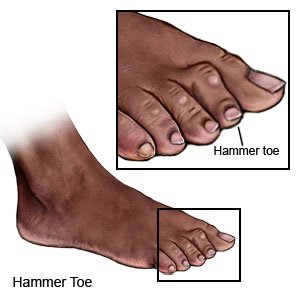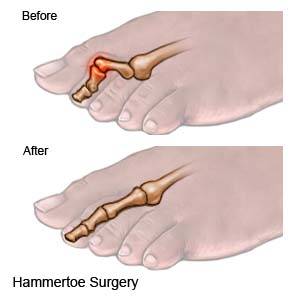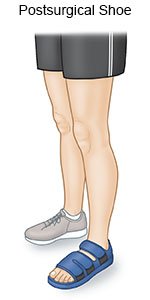Hammertoe Correction
Medically reviewed by Drugs.com. Last updated on Apr 6, 2025.
Hammertoe correction is surgery to straighten your toe. A hammertoe is abnormal bending of your toe. The part of your toe attached to your foot bends up, and the tip bends down.
 |
WHILE YOU ARE HERE:
Before your surgery:
- Informed consent is a legal document that explains the tests, treatments, or procedures that you may need. Informed consent means you understand what will be done and can make decisions about what you want. You give your permission when you sign the consent form. You can have someone sign this form for you if you are not able to sign it. You have the right to understand your medical care in words you know. Before you sign the consent form, understand the risks and benefits of what will be done. Make sure all your questions are answered.
- An IV is a small tube placed in your vein that is used to give you medicine or liquids.
- Antibiotics may be given to prevent an infection caused by bacteria.
- Anesthesia is medicine to make you comfortable during the surgery. You may be given general anesthesia to keep you asleep and free from pain during surgery. You may instead be given local or regional anesthesia to numb your leg or foot. You may still feel pressure or pushing during surgery, but you should not feel pain.
During your surgery:
- One or more incisions will be made in your toe where it attaches to your foot. The kind of surgery you have depends on how much your toe bends. Your surgeon may loosen tendons or ligaments that are causing the abnormal bending. Tendons are bands of tough tissue that connect muscle to bone. Ligaments are bands of tough tissue that connect bones. Your surgeon may move part of one tendon and connect it to a different tendon.
- Some of the joint or bone tissue may be removed to straighten your toe. Your surgeon may place a wire, screws, or pins through your toe bones to keep your toe straight. The incision will be closed with stitches.
 |
After your surgery:
- A medical shoe with a stiff sole or a cast boot you can remove will be put on your foot. You then may be allowed to put full weight on your foot.

- Pain medicine will decrease or take away pain. Do not wait until the pain is severe before you ask for more medicine.
- NSAIDs decrease swelling, pain, and fever.
RISKS:
You may have long-term pain, stiffness, swelling, or numbness in your toe. Your toe may be weak or not sit flat on the ground. A wire or screw placed during surgery may break or come out. You may develop an infection. Damaged blood vessels can lead to gangrene or loss of your toe.
CARE AGREEMENT:
You have the right to help plan your care. Learn about your health condition and how it may be treated. Discuss treatment options with your healthcare providers to decide what care you want to receive. You always have the right to refuse treatment.© Copyright Merative 2025 Information is for End User's use only and may not be sold, redistributed or otherwise used for commercial purposes.
The above information is an educational aid only. It is not intended as medical advice for individual conditions or treatments. Talk to your doctor, nurse or pharmacist before following any medical regimen to see if it is safe and effective for you.
Further information
Always consult your healthcare provider to ensure the information displayed on this page applies to your personal circumstances.
